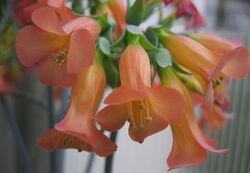Biology:Bryophyllum delagoense
| Bryophyllum delagoense | |
|---|---|

| |
| Flowers | |
| Scientific classification | |
| Kingdom: | Plantae
|
| (unranked): | |
| (unranked): | |
| (unranked): | |
| Order: | |
| Family: | |
| Genus: | |
| Species: | B. delagoensis
|
| Binomial name | |
| Bryophyllum delagoensis (Eckl. & Zeyh.) Druce
| |
| Synonyms[1] | |
| |
Bryophyllum delagoensis, commonly called mother of millions, devil's backbone is a succulent plant native to Madagascar . Like other members of its genus Bryophyllum, it is able to propagate vegetatively from plantlets that develop on its phylloclade margins.[2].[2] Chandelier plant is an alternative common name.[citation needed]
This species' capability for vegetative reproduction, its drought tolerance, and its popularity as a garden plant, relate to this species' becoming an invasive weed in places such as eastern Australia and many Pacific islands. In the Neotropics hummingbirds sometimes pollinate this non-native plant.[3]
Bryophyllum delagoensis is unwelcome because it displaces native plants and contains bufadienolide cardiac glycosides[4] which can cause fatal poisoning, particularly in grazing animals like cattle.[5] During 1997, 125 head of cattle died after eating this species on a travelling stock reserve near Moree, NSW.[6]
Because of the toxicity of this species and its hybrids, and especially of the flowers, it has been declared a noxious weed in New South Wales and Queensland.
See also
- List of poisonous plants
- Mother of thousands (disambiguation)
Footnotes
- ↑ "The Plant List: A Working List of All Plant Species". http://www.theplantlist.org/tpl1.1/record/kew-2684562.
- ↑ 2.0 2.1 {{citation | mode = cs1 | title = Kalanchoe daigremontiana | work = Germplasm Resources Information Network (GRIN) | url = https://npgsweb.ars-grin.gov/gringlobal/taxonomydetail.aspx?21026 | publisher = [[Organization:Agricultural Research ServAgricultural Research Service (ARS), United States Department of Agriculture (USDA) | access-date = 9 February 2015 }}
- ↑ For example sapphire-spangled emerald (Amazilia lactea) in Brazil (Baza Mendonça & dos Anjos 2005)
- ↑ Bryotoxins A, B and C: McKenzie et al. (1987), Steyn & van Heerden (1998)
- ↑ McKenzie & Dunster (1986), McKenzie et al. (1987)
- ↑ les tanner. "North West Weeds". Northwestweeds.nsw.gov.au. Archived from the original on 2009-06-21. https://web.archive.org/web/20090621015741/http://northwestweeds.nsw.gov.au/mother_of_millions.htm. Retrieved 2013-02-19.
References
| Wikimedia Commons has media related to: |
- Baza Mendonça, Luciana & dos Anjos, Luiz (2005): Beija-flores (Aves, Trochilidae) e seus recursos florais em uma área urbana do Sul do Brasil [Hummingbirds (Aves, Trochilidae) and their flowers in an urban area of southern Brazil]. [Portuguese with English abstract] Revista Brasileira de Zoologia 22(1): 51–59. doi:10.1590/S0101-81752005000100007 PDF fulltext
- McKenzie, R.A. & Dunster, P.J. (1986): Hearts and flowers: Bryophyllum poisoning of cattle. Australian Veterinary Journal 63(7): 222-227. doi:10.1111/j.1751-0813.1986.tb03000.x PMID 3778371 (HTML abstract)
- McKenzie, R.A.; Franke, F.P. & Dunster, P.J. (1987): The toxicity to cattle and bufadienolide content of six Bryophyllum species. Australian Veterinary Journal 64(10): 298-301. doi:10.1111/j.1751-0813.1987.tb07330.x PMID 3439945 (HTML abstract)
- Steyn, Pieter S & van Heerden, Fanie R. (1998): Bufadienolides of plant and animal origin. Nat. Prod. Rep. 15(4): 397-413. doi:10.1039/a815397y PDF fulltext
Wikidata ☰ Q137831 entry


